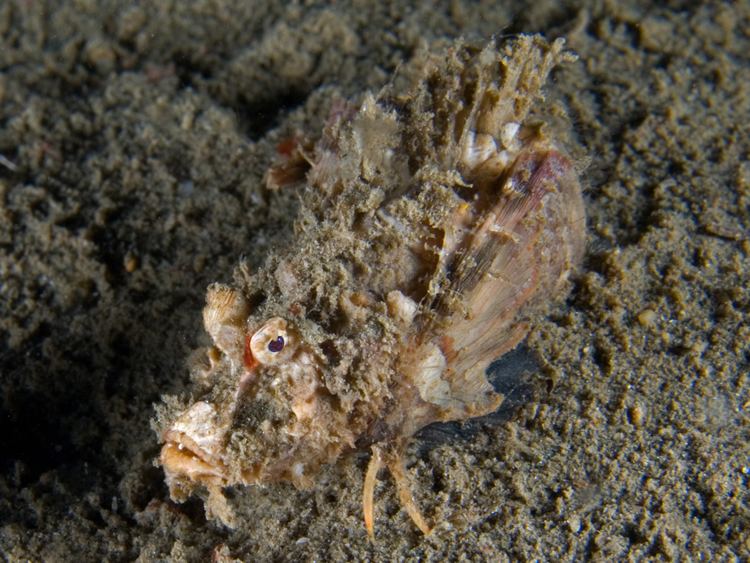Phylum Chordata Rank Genus | Family Synanceiidae Higher classification Synanceiidae Order Scorpaeniformes | |
 | ||
Similar Inimicus didactylus, Inimicus filamentosus, Devil stinger, Synanceiidae, Scorpaeniformes | ||
As seas exhale inimicus mons
Inimicus is a genus of venomous fishes, closely related to the true stonefishes. This genus is a member of the Synanceiidae (devilfishes, goblinfishes, and stonefishes) family of the Scorpaeniformes order of ray-finned fishes. These benthic fishes are found on sandy or silty substrates of lagoon and seaward reefs, in coastal regions of tropical oceans. The ten described species are collectively known by various common names, including Ghoul, Goblinfish, Sea Goblin, Spiny devilfish, Stinger, and Stingfish).
Contents
- As seas exhale inimicus mons
- Ad mortem inimicus
- Species
- Geographic distribution
- Description
- Behavior
- Relevance to humans
- Treatment of envenomation
- References
Ad mortem inimicus
Species
The members of the Inimicus genus are nearly identical in appearance and behavior, and often confused with one another. There are currently 10 recognized species in this genus:
NE: Not Evaluated
Species no longer recognized:
Geographic distribution
Members of the Inimicus genus are distributed mainly in warm tropical waters in the coastal regions of Indo-Pacific oceans. Their range does however extend a little into the subtropical zone. The waters of the Red Sea off the coast of Egypt appear to mark the westernmost limit of their range, while specimens have been reported as far to the east as New Caledonia. The northern coast of New South Wales, Australia marks the southernmost extent of their range, which extends as far to the north as Japan's Aomori, the northernmost prefecture of Japan's main island. Inimicus are benthic fishes, living mainly on the bottom of mangrove swamps and coral reefs, at depths between 5 and 450 meters.
Description
Adults are typically 13-25 centimeters in length, and can weigh up to 480 grams. The body color can be a dull yellow, gray, brown, or rust in color with light blotches, and very similar to that of the surrounding sandy or coral seabed in which they are found. This coloration acts as a camouflage which renders them extremely difficult to detect in their natural habitat. The skin is without scales except along the lateral line, and is covered with venomous spines and wartlike glands which give it a knobby appearance. The head is flattened, depressed and concave. The eyes, mouth and nostrils project upwards and outwards from the dorsal aspect of the head. Sexual dimorphism is not believed to occur in this genus.
Fin morphology:
Behavior
Inimicus are piscivorous ambush predators. They are nocturnal and typically lie partially buried on the sea floor or on a coral head during the day, covering themselves with sand and other debris to further camouflage themselves. They have no known natural predators. When threatened, they spread their brilliantly colored pectoral and caudal fins as a warning. Once dug in, they are very reluctant to leave their hiding places. When they do move, they display an unusual mechanism of subcarangiform locomotion---they crawl slowly along the seabed, employing the four lower rays (two on each side) of their pectoral fins as legs.
The paired pectoral fins of these fishes are a remarkable example of their adaptation to life in a benthic environment. No longer useful or necessary for aiding the animal in maneuvering within the water column, the fins have taken on a number of other functions useful to life as a demersal fish. Among these include probing for food items, propping the forward part of the body away from the bottom, and the aforementioned subcarangiform locomotion.
Inimicus is not the only fish that demonstrate this type of ambulation; it has been extensively described in other related benthic Scorpaeniformes fish such as the Sea robin, Flying gurnards, and the Tub Gurnard, Chelidonichthys lucerna. This type of locomotion, based on voluntary and coordinated movements of paired pectoral fins, is believed by some to be a precursor to the later development of similar ambulation in terrestrial vertebrates.
Relevance to humans
Like all known members of the family Synanceiidae, all members of the genus Inimicus possess a complex and extremely potent venom. It is stored in glands at the bases of needle-like spines in their dorsal fins. Upon contact with the dorsal fin, the fish can deliver a very painful, potentially fatal, sting. The venom consists of a mixture of proteolytic enzymes, including stonustoxin (a hemotoxin), trachynilysin (a neurotoxin), and cardioleputin (a cardiotoxin). Envenomation results severe and immediate local pain, sometimes followed by shock, paralysis, tissue necrosis, and even death.
Despite the obvious risks, one species of Inimicus, I. japonicum, is commercially cultured in Japan. It is used as a food fish there, and it also has applications in Chinese medicine.
Treatment of envenomation
Envenomation by Inimicus species is characterized by immediate and severe local pain. Medical aid must be sought at the earliest opportunity after envenomation. Recommended first aid treatment includes immersion of the affected area in hot water. Immersing the injured area in water at a temperature of at least 45 °C (113 °F) can partially denature the proteolytic enzymes in the venom. Some relief can also be obtained by infiltrating the envenomation site with a local anesthetic. For more extreme cases, an intramuscular injection of a specific horse-derived antivenom can be lifesaving. Tetanus toxoid vaccine should also be administered, if indicated. Surviving victims often suffer localized tissue necrosis and nerve damage, leading to atrophy of adjoining muscle tissues.
Click here to see more photographs of various specimens of the Inimicus genus.
